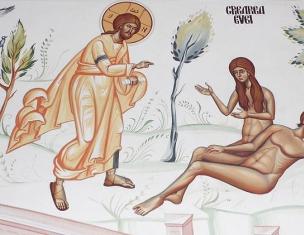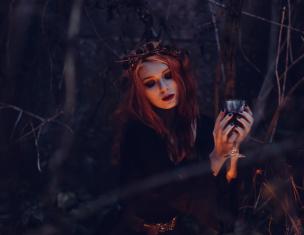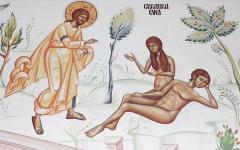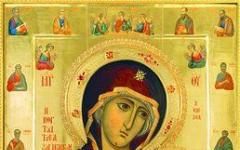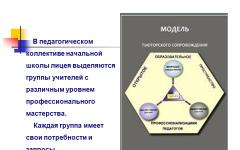The very sound of the phrase “captain’s daughter” paints the image of Masha Mironova as completely different, not the same as described on the pages of the story. It seems that this should be a girl with a mischievous, daring character, bold and flirtatious.
However, the main character of the book is a completely different girl. She is completely devoid of coquetry, she is not characterized by the enthusiasm of youth and the desire of young girls to please everyone without exception. Mary presents a different image. Masha Mironova - every schoolchild's essay quotes this passage - “chubby, ruddy, with light brown hair, smoothly combed behind the ears,” a modest eighteen-year-old girl. It is unlikely that any of the young readers will consider her an attractive person worthy of imitation.
Life and education
The image of Masha Mironova is inextricably linked with the characteristics of her parents - Ivan Kuzmich and Vasilisa Egorovna. Their life passed in the Belogorsk fortress, not far from Orenburg. They lived in a small village with cramped streets and low huts, where the commandant occupied a simple wooden house.
Maria Mironova's parents were sincere and warm-hearted people. The captain was known as a poorly educated man, but he was distinguished by his honesty and kindness to people. Vasilisa Egorovna is a hospitable woman, accustomed to the military way of life. Over the years, she has learned to deftly manage the fortress.

In short, the girl lived a secluded life, communicating mainly with her parents.
Her mother said that Masha is a girl of marriageable age, but she has absolutely no dowry, so it’s good if there is someone who will marry her. It is possible that Vasilisa Egorovna shared her thoughts with her daughter, which could hardly have added to her confidence.
The true character of the captain's daughter
The image of Masha Mironova, at first glance, will probably seem quite boring to many. Pyotr Grinev also didn’t like her at first. Despite the fact that Masha lived alone, one might say secluded, surrounded by her parents and soldiers, the girl grew up very sensitive. Maria, despite her apparent timidity, was a brave, strong person, capable of sincere, deep feelings. Masha Mironova refused Shvabrin’s offer to become his wife, although he, by society’s standards, was an eligible bachelor. Maria had no feelings for him, and the captain’s daughter did not agree. Having fallen in love with Pyotr Grinev, Masha openly talks about her feelings in response to his explanation. However, the girl does not agree to a marriage that the groom’s parents did not bless, so she moves away from Grinev. This suggests that Masha Mironova is an example of high morality. Only later, when Peter's parents fell in love with her, Maria became his wife.

Trials in the life of Maria Mironova
This girl's life cannot be called easy. However, the image of Masha Mironova is revealed more fully under the influence of difficulties.
For example, after the execution of her parents, when Maria was sheltered by the priest, and Shvabrin put her under lock and key and tried to force her to marry him, she managed to write to Pyotr Grinev about her situation. Deliverance came to the girl in a completely unexpected guise. Her savior was Pugachev, the killer of her father and mother, who released her and Grinev. After her release, Peter sent the girl to live with his parents, who sincerely loved Mary. Masha Mironova is the image of a real Russian, but at the same time vulnerable and sensitive. Despite the fact that she faints from a cannon shot, in matters concerning her honor, the girl shows unprecedented strength of character.

The best spiritual qualities of the heroine
The image of Masha Mironova is revealed even more fully after the arrest of Pyotr Grinev, when she showed the true nobility of her nature. Maria considers herself to be the culprit of the misfortune that happened in the life of her lover and constantly thinks about how to rescue her groom. Behind the girl’s apparent timidity lies a heroic nature, capable of anything for the sake of a loved one. Masha goes to St. Petersburg, where in the garden of Tsarskoye Selo she meets a noble lady and decides to tell her about her misfortunes. Her interlocutor, who turned out to be the empress herself, promises to help. The determination and firmness shown by the girl saves Pyotr Grinev from imprisonment.
The image of Masha Mironova in the story undergoes strong dynamics. The misfortune that happened to Grinev allows her to reveal herself as a strong, mature, one might say, heroic personality.

Maria Mironova and Mashenka Troekurova
A. S. Pushkin began writing the story “The Captain's Daughter” in 1833. The idea for this book most likely arose when the writer was working on the story “Dubrovsky”. This work by Pushkin also contains a female image. Masha Mironova, about whom schoolchildren usually write essays, is a completely different person than her namesake.

Maria Troekurova also lives alone, albeit in pampered conditions, on her parents' estate. The girl loves novels and, of course, is waiting for the “Prince Charming.” Unlike Masha Mironova, she was unable to defend her love; she did not have the determination to do so.
It seems that with the happy ending with which The Captain's Daughter ends, the author is trying to smooth out the bloodshed that occurred in Dubrovsky.
Image of Masha Mironova and Tatyana Larina
The image of our heroine is to a certain extent consonant with another female character created by A. S. Pushkin in the novel “Eugene Onegin” - Tatyana Larina. "The Captain's Daughter" was written about five years later than "Eugene Onegin". The image of Masha Mironova is revealed more fully and deeply than the characterization of Tatyana. Perhaps this is partly due to the fact that the author himself has become a little more mature. Masha is also, but even more than Tatiana, related to the people's environment.

The main theme and idea of the work
The main problem that Pushkin identifies in his novel is the issue of honor and duty. This can be guessed from the epigraph, presented in the form of a folk proverb: “Take care of your honor from a young age.” The main characters of the story demonstrate these qualities in their own way. Pyotr Grinev, despite difficult circumstances, is faithful to this oath. Shvabrin, without hesitation and without delving into the problems of the country and the people, goes over to the side of Emelyan Pugachev. Grinev's servant, Savelich, is devoted to Peter, fulfills the old master's orders, watches over his son, cares for him. Ivan Kuzmich, the commandant dies while fulfilling his duty.
The image of the main character of the story is also integrally connected with the concepts of duty, courage and loyalty. Maria Mironova, like the old captain, is more likely to die than to do something contrary to her conscience.
Another leading theme of "The Captain's Daughter" is the theme of family, home, personal relationships. In the story, the author presents two families - the Grinevs and the Mironovs, who passed on the best human virtues to their children, Peter and Maria.
It is in the family environment that moral qualities such as spirituality, philanthropy, and mercy are formed. This theme in the story is as important as the theme of debt.
The image of Masha Mironova is briefly described in just a couple of words, and in the mind, most often, the image of a modest, ruddy, round-faced girl emerges. The depth of her character makes you realize how much is hidden under her simple appearance.
We encounter many female images on the pages of A. S. Pushkin’s works. The poet has always been distinguished by his love for a woman in the highest sense of the word. A. S. Pushkin’s female images are almost an ideal, pure, innocent, lofty, spiritual. Of course, not the last place in the gallery of female images is occupied by the heroine of the novel “The Captain's Daughter” Masha Mironova. The author treats this heroine with great warmth.
Masha is a traditional Russian name; it emphasizes the simplicity and naturalness of the heroine. There are no original, outstanding features in this girl; the definition of “sweet girl” fits her perfectly. And at the same time, this image is poetic, sublime and attractive.
Masha Mironova was brought up in a patriarchal family that adhered to ancient noble traditions. Because of this, she is obedient, calm, and modest. She will never cross the boundaries of decency, will not compromise her moral duty and will not go against her conscience. So, she would never have married Shvabrin, even if this decision threatened her with death. Let us remember in what condition Pugachev and Grinev find locked Masha. Her upbringing, her principles did not allow Masha to bow to Shvabrin.
A.S. Pushkin subjects his heroine to the test of love, and she passes this test with honor. To achieve prosperity, Masha had to endure many hard blows: her beloved was wounded in a duel, then the groom’s parents did not give their blessing for a legal marriage, and her own parents died. Pugachev's rebellion bursts into Masha's measured life. Ironically, this event, instead of separating the two lovers, united them.
Nowhere is the character of Masha Mironova more evident than in the last pages of the book, where she, without any doubt, goes to Tsarskoe Selo to ask the Empress to pardon Grinev. This act is bold because a young girl, who does not know life, is traveling into the unknown alone, and doubly bold because she wants to stand up for a disgraced nobleman, which is very risky for herself. She enters into a fight not only for her love, but also for justice. The trials that befell Marya Ivanovna mentally burned her and made her stronger. She was not broken by the death of her parents, Shvabrin’s harassment, or Grinev’s arrest. But at first she seemed so weak and helpless, she was afraid of shots, and fainted. But when fate put her alone at a crossroads, she found the strength to fight for her happiness. Masha became more mature in these trials.
A.S. Pushkin makes his heroine suffer because he treats her reverently and tenderly. He knows that she will endure these sufferings, revealing in them the most beautiful sides of her soul.
Masha Mironova has a highly developed sense of duty and spiritual nobility. Her concept of duty develops into the concept of fidelity. Masha Mironova remained faithful to her heartfelt affection despite her fear. She is her father's true daughter. Mironov in life was a gentle and good-natured person, but in an extreme situation he showed determination worthy of a Russian officer. Masha was the same: she was timid and impressionable, but when it came to her honor, she was ready, like her father, to die rather than do anything contrary to her conscience.
Masha Mironova’s spiritual qualities are wonderful: moral impeccability, loyalty to her word, determination, sincerity. She is capable of loving sincerely, ardently and selflessly. And as a reward she gets the happiness she deserves.
A.S. Pushkin, creating the image of Misha Mironova, put into it his soul, his love, his desire to see in a woman the embodiment of those high spiritual qualities that are so valued at all times. And Masha Mironova rightfully adorns the gallery of images of Russian women created by our classics.
the year brings seven magical colors. With these paints you can paint whatever you want, and what you draw will come to life. If such paints fall into the hands of an evil boy or an evil girl, they can cause a lot of trouble. Therefore, Santa Claus checks the hearts of children for a long time, and then chooses which of them to give magic colors to.
Please place the punctuation marks and answer the question, in which of the four sentences should a dash be placed? Please place the punctuation marksniya, and answer the question, in which of the four sentences should a dash be placed?
18. In the sentences below from the text read, all commas are numbered. Write down the number indicating the comma between the parts of the complexsentences connected by a coordinating link.
Entering the classroom, (1) Ilya thrust the kitten to Sanya who turned up, (2) and he hid it in his briefcase. At the last break, the main enemies of the human race, (3) Murygin and Mutyukin, (4) looked for a little for the kitten, (5) but soon forgot.
19. In the sentence below from the text read, all commas are numbered. Write down a number indicating a comma between parts of a complex sentence connected by a coordinating connection.
You see (1) how the girl loves Katya: she almost never lets her out of her arms, (2) and goes to bed, (3) and eats with her, (4) and you and I miss you on the nightstand day and night.
20. In the sentences below from the text read, all commas are numbered. Write down a number indicating a comma between parts of a complex sentence connected by a coordinating connection.
Anna Nikolaevna talked about the latest news from the front, (1) and Vovka, (2) he had such an honorable duty, (3) moved the flags on the map under the guidance of the teacher.
Ours beat the Fritz, (4) the flags moved every day, (5) expanding the front of attacks, (6) and that day they jumped far forward.
21. In the sentences below from the text read, all commas are numbered. Write down the numbers indicating commas between parts of a complex sentence connected by a coordinating connection.
There was no crown on my head, (1) alas, (2) but there were crown-bearing habits, (4) and I really loved being in charge.
The kingdom of toys reflected the real world in its own way, (5) without humiliating anyone, (6) but elevating me.
22. In the sentences below from the text read, all commas are numbered. Write down a number indicating a comma between parts of a complex sentence connected by a coordinating connection.
She came up with a biography for the virtual Mitya without difficulty, (1) and took the photograph from her mother’s album: a young man sitting astride some kind of fence and smiling beautifully. His eyes are light, (2) and his hair is dark, (3) as ordered...
Having done everything (4) that was necessary, (5) to fill out Mitya’s page, (6) Nina exhaled with satisfaction and leaned back on the computer chair, (7) to admire her handiwork.
23. In the sentence below from the text read, all commas are numbered. Write down a number indicating a comma between parts of a complex sentence connected by a coordinating connection.
He kept sitting in the same place, (1) near the foot of the bed, (2) and, (3) when someone leaned over him, (4) he put his jagged claw forward with menacing impotence.
Read the sentences from the left column.
Is their information sufficient to understand?
What words signal that the situation is not fully described and requires clarification? Explain the main clauses using the subordinate clause given on the right in the “For reference” section.
Which word in the main sentence does the subordinate clause refer to?
For information
In the main sentence, as part of a complex sentence, demonstrative words are often used, which are pronouns. that, such, this, all, everything, everyone, everyone, no one, nothing, someone, something etc. or adverbs there, from there, then, so, everywhere, everywhere etc. These words indicate that the situation of reality is not fully reflected in the main sentence and that the main sentence is followed by a subordinate clause.
For example: It often happens to us / And see work and wisdom there / Where you just have to guess / Just get down to business. (I. Krylov.) Caravans are already passing through those rocks, / Where only fogs and king-eagles rushed. (M. Lermontov.)
Demonstrative words form certain pairs with allied words and some conjunctions: that - which, that - who, such - which, so - so that etc.
The structure of complex sentences with an indicative word in the main word can be schematically depicted as follows:

98. Write down the index words with the “clue” highlighted - the letter T. In what part of a complex sentence are they located? Why are these words called a hint?
T from
T what a
T am
T good luck
T when so
99. Write it down using the necessary punctuation marks. In complex sentences, underline demonstrative words as parts of the sentence; At the top, indicate which part of speech they are expressed in.
Make an outline of the highlighted sentence.
1. It is known what significance a song has in the life of a Russian person. For a long time, foreigners who came to Russia were amazed by the flood of songs that from time immemorial flooded Russian life in all directions.. 2. The diversity and perfection of Russian song creativity is amazing. Of course, the first place should be given to what was given by the Russian people in the field of church chant. For centuries, the Russian people, with their infantilely pure souls, have acquired such a great joy of warm prayerful repose from which we have largely lost the habit.
100. Read the text using demonstrative words in place of the gaps. Which sentence expresses the main idea of the text? Write out complex sentences. Make diagrams of the highlighted sentences.
A kind person overcomes all human shortcomings by his very kindness. In the old days, in Ancient Rus', the good was not called stupid. The fool in Russian fairy tales always acts smartly and always gets what he wants in life precisely because he is kind. The fool of Russian fairy tales caresses the ugly little hunchbacked horse and lets go of the bird that came to steal wheat. They will then do for him in difficult times - what he needs. Kindness is always smart. A fool tells everyone the truth because for him there are no conventions and he has no fear.
The Russian people love fools not because they are stupid, but because they are smart. Smart --, with a higher mind, which is not contained in cunning and deception of others, not in trickery and the successful pursuit of one's own narrow gain, but in --, wisdom, which knows the true price of all falsehood, ostentatious beauty and hoarding and which sees the price in committing good to others, and therefore to oneself as an individual.
And the Russian people do not love every fool and eccentric, but only the one who loves the ugly little hunchbacked horse, does not offend the dove, does not break the talking tree, gives his own to others, saves nature and respects his parents. Such a fool will not only get a beauty, but the princess will give her an engagement ring from the window, and with it half the kingdom-state as a dowry.
(According to D. Likhachev.)
101. Composition. You, of course, have met kind people in life, kind heroes in books... Tell us about one of them. What and how was the kindness of the person you will write about manifested? You may end up with a story, description, reasoning, description with reasoning, diary entry, etc.
102. Correct speech defects in sentences from children's essays. Explain what they are related to.
1. Father Frost and Snow Maiden took us to where the concert was. 2. His devotion to Masha Mironova was manifested in the fact that when Masha was in the hands of villains, he saved her. 3. When Sonya reached the last lines, she read them in a trembling voice. 4. When Pugachev captured the fortress and hanged Mironov, Pugachev wanted to hang Grinev too.
103. Find errors. Use demonstrative words in the correct form or exclude them. Write down the sentences in corrected form.
1. Could you please clarify how you feel about the position of our movement. 2. No one had any doubts that the festival would take place. 3. The director asked to report on everything that was happening at the plant. 4. It will not be entirely convenient for me to report to you everything that was said. 5. You understand that Katya’s life will differ from certain standards. 6. There is no need to check who pays every day. 7. His very arrival means that he wants company.
Subordinating conjunctions since, because, after, since etc. can be dismembered. The first part of the conjunction in this case remains in the main clause and becomes an indicative word. This depends on the communicative task of the speaker or writer and happens in cases where the speaker or writer needs to particularly emphasize some event that is mentioned in the main part of the sentence.
If words such as only, only, also, first of all, precisely, obviously, probably, maybe, as well as particles and, no, they are always dismembered before the union What a comma is added. For example:

104. Read complex sentences. Name the compound conjunctions, explain the placement of commas. Write the sentences using the words given in brackets. At the top, write what part of speech the inserted words are. Underline the demonstrative words as parts of the sentence.
because - because; in order to - in order to; thanks to the fact that - thanks to the fact that
1. People sat silently because they did not want to draw attention to themselves (only). 2. He entered the Faculty of Philology in order to seriously study linguistics (and). 3. My brother became a good gymnast, thanks to the fact that since childhood he went to the sports section (primarily). 4. There is a lot here that reminds us of Lermontov, because part of the poet’s life is connected with the Caucasus (namely).
105. Write the sentences using parentheses and punctuation. Indicate what parts of speech the highlighted words are.
1. I guessed about the sad consequences of yesterday’s incident That's why) the facial expression that my father always has after my tricks. 2. I must have looked distracted That's why) that mom repeated her question twice. 3. Bear was grateful to his friend (That's why that he sympathized with him and (That's why that helped in difficult times. 4. He crossed the river (on) that small bridge that his grandfather spoke about. 5. They walked (from) that house that stood on the edge of the village. 6. (From) that that you will be nervous, nothing will change. 7. You failed the test only (because) you were sick for a long time.
106. Presentation. Read the text about the illustrations of the famous Russian artist Nikolai Kuzmin, who sought to comprehend the connection that exists between Pushkin writing and Pushkin drawing. Restore the order of the parts of the text highlighted in paragraphs. Retell the text in detail in the logical sequence that you established.
The artist not only touched the magical world of Pushkin’s creativity, he entered it. And he brought the reader along. It’s not for nothing that you pick up the edition of the novel, where Kuzmin’s drawings run across the margins, with special excitement: it sometimes seems that in front of you is a manuscript that has not yet cooled down from the running of the magic pen.
Now we can already talk about the tradition of turning to the sketches and sketches of the poet himself in Russian graphics, although artists take different paths to Pushkin. But what Kuzmin did in illustrating Eugene Onegin is unique.
The first who paid the most serious attention to Pushkin’s drawings was the graphic artist Nikolai Kuzmin. His drawings for the novel “Eugene Onegin” are placed in the book like Pushkin’s sketches - in the margins. They are like instant sketches, made almost on the fly. But it only seems so. With what patience, with what love it was necessary to delve into the poet’s drawings in order to learn not to imitate him, no, but to draw, with every line, every stroke reminiscent of Pushkin’s unique style! And so, scattered between Onegin’s stanzas, the heroes of the novel Onegin, Lensky, Larina’s young ladies, the secular crowd, the St. Petersburg street live at ease before our eyes... And between them, more and more often - who is it, familiar and unfamiliar? - a thin face with sideburns, surprised thin eyebrows flashes more and more often...
In Kuzmina's drawings, Pushkin becomes the hero of his novel, and the most important and most interesting hero. And the point is not only that the artist’s Pushkin looks like a self-portrait, but that the poet’s image has finally taken the place in the novel that it deserves. The line of the drawing is light and musical, like a Onegin stanza, it is in tune with this stanza. It is impossible to draw Onegin’s letter, or the poet’s thoughts about Lensky’s death, or Tatiana’s longing for Onegin who left. But it is possible to depict on paper how Onegin is bored in his office, how Lensky falls in the snow, how Tatyana wanders around Onegin’s house. It is possible to draw characters in such a way that you can feel Pushkin’s sympathy and Pushkin’s irony behind them.



